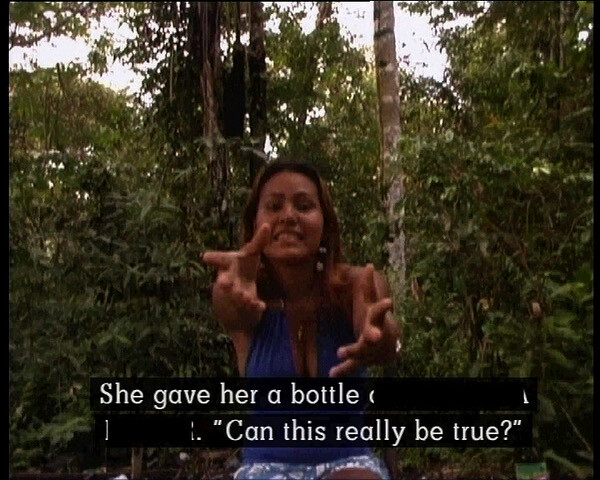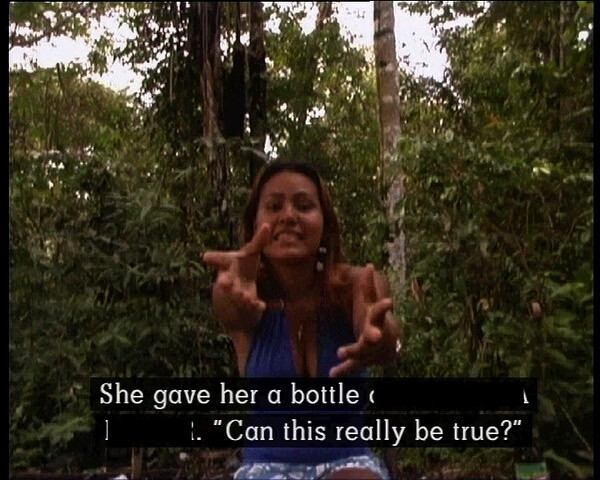Superflex, Judith Barry, and Józef Robakowski
October 10, 2019, 9pm
224 Greene Avenue
Brooklyn, NY 11238
USA
Join us at Bar Laika on Thursday, October 10, 9pm as we revist e-flux video rental (EVR), a seminal e-flux project organized in 2004 by Julieta Aranda and Anton Vidokle. This week we present Superflex’s Guarana Power Commercials, Judith Barry’s Casual Shopper, and Józef Robakowski’s Market.
Superflex, Guarana Power Commercials, 11:16, 2004
In 2004, a series of five commercials were made together with the guaraná farmers behind the Guaraná Power soft drink. Each of the commercials contains a narrative about the product told by the farmers themselves. Total duration 11:15 minutes. In 2003, SUPERFLEX initiated a collaboration with a guaraná farmers’ cooperative from Maués in the Brasilian Amazon in order to produce the Guaraná Power soft drink. The farmers have organised themselves in response to the activities of the multinational corporations XxXxx and XxxxxXx, a cartel whose monopoly on purchase of the raw material has driven the price paid for guaraná seeds down by 80% while the cost of their products to the consumer has risen.
Judith Barry, Casual Shopper, 06:11, 1981
Casual Shopper was inspired by three things: the realization that there could be a female ‘flaneuse’ après Walter Benjamin’s flaneur; that a woman’s ‘gaze’ could produce narrative thus countering Laura Mulvey’s famous observation about classic HW film —- that men ‘act’ and women (only) ‘appear’; that visual pleasure could proceed from a ‘feminist perspective’ within cinematic space (See Judith Barry, “Casual Imagination,” Blasted Allegories, ed. Brian Wallis, MIT press, Cambridge 1987). Casual Shopper is about people who shop casually, those who go to the mall just to browse, at their leisure, when there is nothing better to do. This is a love story that never advances beyond that which can be imagined, which is never consummated, but which returns to a prosaic scene where demands are exchanged and desire circulates endlessly. Share the fantasy.
Józef Robakowski, Market, 04:26, 1970
In Market, the first film Robakowski produced with the Workshop of Film Form, he attempted to expose film’s potential to create an illusion of reality as it was exploited by professional cinema. He showed that the feeling of reality film creates is merely a product of technology and, more precisely, the effect of the standard frame rate in the camera or the projector (24 frames per second). A slight modification of this speed or filming at a different frame rate (say, five frames every two seconds, as is the case in Market), gives an entirely different image of recorded reality.
—-
This Fall we would like to revisit e-flux video rental (EVR), a seminal e-flux project organized in 2004 by Julieta Aranda and Anton Vidokle. EVR started with a handful of artists videos at a tiny storefront on Ludlow street and went on to become a video archive of more than 1000 films and single channel video works by more than 600 artists that traveled to more than twenty cities all around the world, until it finally found a permanent home in the collection of the Museum of Contemporary Art in Ljubljana in 2011.
EVR was conceived as an alternative means for distribution and circulation of video art. In spite of the fact that many artists of the 1960s and 70s were drawn to working with video because it was relatively inexpensive and easy to reproduce and distribute, the subsequent assimilation of video art into the precious-object economy of the art market has significantly limited access to video works. EVR began as a functional reflection and inversion of this process. Comprising a public screening room, a film and video archive that grew with each installation of EVR, and a free video rental shop, VHS tapes could be watched in the space or checked out and taken home once a viewer has completed a membership form.
We plan to view the entirety of the contents of EVR at Bar Laika in a series of weekly screenings. This may take a few years…
For more information, contact laika [at] e-flux.com.

